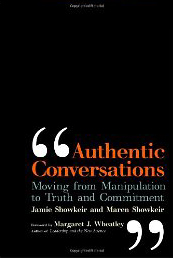TAKING YOUR SIDE
A recent thread on our Authentic Conversations Facebook page addressed one of the conversations skills that people really struggle with. It began with this statement posted by Jamie:
“Here's a thought: Taking the other person's side demonstrates understanding and is the heart of collaboration.”
The first response to this posting came from a long-time, dear friend — a skilled and seasoned organization development consultant. He wrote:
Here is why in the book and in our work we advocate stating — out loud — the other person’s point of view during a conversation:
- To deepen your understanding of their point of view, whether you agree with it or not
- To demonstrate you are listening (you can't accurately restate if you didn't really hear it)
- To give them the opportunity to feel truly understood
Why are people reluctant to take the other side? It usually boils down to fears that doing so will:
- Give your point of view more power than mine
- Validate your position in a way that will keep my argument from prevailing
- Lead to a conclusion that I actually do agree with you
Collaboration means caring as much about the good of the whole as I do about winning my position. Taking the other side is a powerful way to be collaborative in the moment.
Want to join our Facebook conversation? Check it out, we'd love to have your participation!


 maren
maren